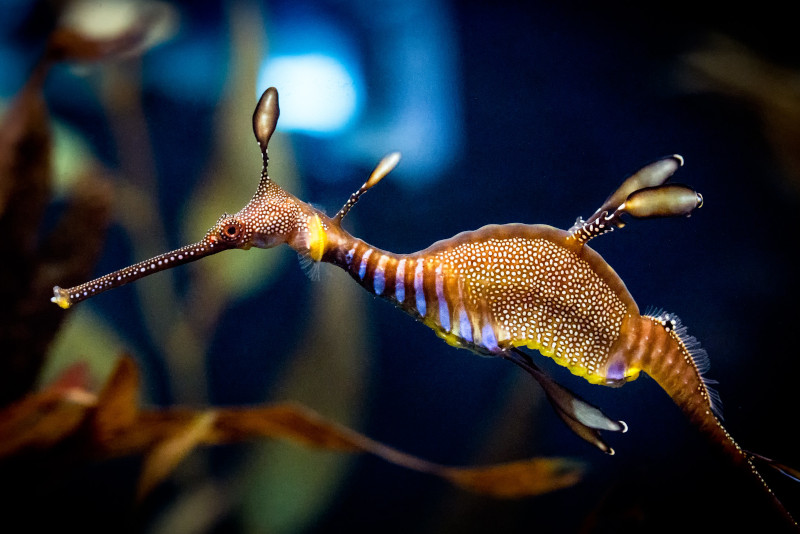
Weedy Seadragon Facts
- The most often employed common name for this startling product of Nature and evolution is the unusual term of Weedy Seadragon. It does have at least one other accepted general tag, though. That’s the less catchy moniker common seadragon.
- Inside of the scientific community, however, it’s perhaps better known by its technical designation. Unfortunately, that’s an almost unpronounceable one for most laypeople. That’s because the animal holds the formal epithet of Phyllopteryx taeniolatus.
- The remarkable creature received that tongue-twisting appellation due to the efforts of Bernard Germain de Lacépède. The noted French naturalist accomplished the first recognition of it as a separate and distinct species. He managed that in 1804.
- Fortunately, the amazing Weedy Seadragon appears to be maintaining a healthy, thriving population base. That pleasant state also seems to hold true throughout the entirety of its native range. the IUCN therefore presently lists the fish as Least Concern.
- It nevertheless faces the same potential threats to its continued existence as a species as all forms of life on earth now do. Most of these stem from the actions of man. They include the perils posed by habitat loss, pollution, and ongoing climate change.
Related Articles
Weedy Seadragon Physical Description
The astounding Weedy Seadragon typically immediately catches the eye of anyone fortunate enough to encounter one. The amazing animal generally does so due to more to its distinctive appearance, though. That’s true since it’s not an overly large variety of fish.
Despite its unique form, however, it does follow one physical trait common to most animal species. That’s in the fact that it displays a certain degree of the physiological characteristic known as sexual dimorphism. But in its case, this manifests in both color and shape.
As a general principle, mature individuals of both sexes attain the same approximate body length. Large examples sometimes measure 18 in (45 cm) long. Few manage to attain quite this length, though. Variations occur wholly regardless of gender, however.
One way in which the sexes distinguish themselves regards the design of the body structure. Males of the species tend to develop slimmer shapes than their female counterparts. Though they display the same basic color pattern, they usually show darker shades of each.
The Weedy Seadragon commonly presents different color patterns in shallow water than it does at greater depths. In deeper water, these typically consist of burgundy-red hues. Yet, in shallower areas, it more frequently shows reddish-orange with spots and bars.
The animal is also known for its unusual appendages. These consist of numerous leaf-like structures protruding from tail, body, and head. Several of their fins also evolved as transparent in nature. Bony plates and long, sharp, bony spines also appear on the body.
- Kingdom: Animalia
- Phylum: Chordata
- Class: Actinopterygii
- Order: Syngnathiformes
- Family: Syngnathidae
- Genus: Phyllopteryx
- Species: P. taeniolatus
Weedy Seadragon Distribution, Habitat, and Ecology
Sadly, the fascinating Weedy Seadragon apparently evolved as native to relatively small expanse of the marine regions of the globe. The precise location of that zone of habitation rarely surprises anyone, though. That’s because it’s native to waters off of Australia.
That precise placement creates a unique situation, however. That’s due to the fact that its territory technically qualifies as covering parts of the southwest Pacific Ocean, the Southern Ocean, and the eastern Indian Ocean. All that despite its range being small!
This occurs because all three happen to merge in the general area off shore of the continent. Within this area, the marvel of evolution developed extremely precise requirements regarding its choice of habitat. This trait significantly reduces its potential habitat range.
The animal only lives in regions in extremely close proximity to the coastline. There, the species is present at depths from the shoreline to no more than 160 ft (50 m). It also prefers clumps of seaweed, seagrass meadows, seaweed beds, and sometimes rocky reefs.
Like its cousin, the seahorse, the Weedy Seadragon evolved as a slow-moving creature. It’s also most commonly seen either alone or in pairs. It feeds as a carnivore, with its primary food consisting of either zooplankton or various types of extremely small crustaceans.
Subsequent to mating, the females lay roughly 120 eggs into a pouch, located under tail of the male. He then carries them, generally for around one month. Most young require roughly 28 months to reach maturity, and an average lifespan equals approximately 6 years.
Species Sharing Its Range
Check out our other articles on 4 Charming Christmas Season Species, Eurasian Brown Bear, Mount Erebus, Mountain Apollo, Indian Vulture, Strawberry Tree, Giant Girdled Lizard
